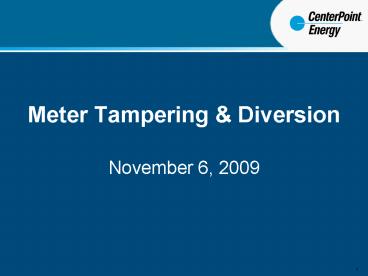Meter Tampering - PowerPoint PPT Presentation
1 / 11
Title: Meter Tampering
1
Meter Tampering Diversion
- November 6, 2009
2
Diversion Has Increased Since 2004
Average All-in Price for Electricity in
ERCOT (Source PUCT Report to 81st Legislature)
CNP Confirmed Diversion Cases Dedicated
Diversion Resources
3
As Diversion Increased, Amounts Re-billed to REPs
Increased
Lengths of back billing periods for 2007-2009
4
Diversion is Detected by Various Means
- Field Technicians may discover diversion during
the execution of service orders, such as
Move-Ins, Move-Outs, Disconnections,
Reconnections. Field Techs will enter a
notification into the Mobile Data system, which
is reviewed by Revenue Protection the next day. - Meter Readers - Given the volume of meters a
meter reader must read each day, and the speed at
which the meter reader must work, the vast
majority of diversion is not detected by meter
readers.
5
Diversion is Detected by Various Means
- Usage Analysis may detect suspicious reductions
in load that result from diversion. Two new
tools were developed in 2009 to identify
potential tampering - Zero Usage Report For active accounts, if
current and previous months have zero usage, then
account is investigated. - 40-45 of investigated accounts result in a
finding of diversion. - 50 Usage Reduction Report Compares current
month with the same month 1 and 2 years ago. If
current month usage is 50 less than either of
those months, account is investigated. - Approximately 80 of investigated accounts result
in a finding of diversion. - Seasonal homes, traveling customers, and
unoccupied rental properties may appear on either
report, but will not result in a finding of
diversion.
6
Diversion is Investigated, Evidence is Secured,
and the Account is Re-billed
- Once the condition is reported, Revenue
Protection reviews the account and the account is
investigated. - A meter maintenance order is issued to inspect,
test and replace the meter. The type of meter
and type of tampering will dictate the skill
level required to correct the condition. Meter
maintenance orders are usually worked within 15
days. - Once the meter maintenance order has been
completed in the field, the investigator will
determine if a billing adjustment is warranted
and identify the period of time and method of
calculation of usage (new meters registration,
previous months/years registration or similar
conditions). - Evidence is gathered and documented including
but not limited to - Meter Accuracy Test. If meter test falls below
ANSI standards, meter is stored as evidence for a
period of two years. - Physical evidence if applicable (Meter, Meter
Seals, jumpers) - Affidavit
- Photographs, if applicable
- Historical usage and rebilling summary
- All evidence documentation is scanned and
uploaded to SharePoint for electronic processing.
7
Diversion is Investigated, Evidence is Secured,
and the Account is Re-billed
- The investigation is usually completed within 7
days of the completion of the meter maintenance
order. - Revised estimated usage, wires charges, and labor
material charges are forwarded to Retail
Electric Provider, facilitating their re-billing
of the customer for diverted amounts.
8
CNPs Re-billing Policy has Recently Changed
- Back-billing will be limited to a period of not
more than 12 months. - Billing will be limited to the current REP of
Record, or the previous REP if the current REP of
Record has been the REP for less than 30 days. - The interim back-billing limit will remain in
effect until a final rule in Project No. 37291
goes into effect.
9
CNP Has Recently Implemented a New Evidence
Process
- REPs should direct their requests for evidence
and other correspondence concerning tampering and
diversion to the following e-mail box - ManagingEffortsTowardEnergyRecovery_at_CenterPointE
nergy.com - CNP will respond to requests for evidence with
documentation of the tampering / diversion,
including the affidavit, photographs (if
applicable), and a listing of physical evidence
retained by CNP. - REPs will ordinarily receive a reply within
fifteen (15) business days however, collection
of evidence materials from some of our outlying
Service Centers may take a longer time to process.
10
Prosecution of Diversion Presents Several
Challenges
- Most diversion cases involve amounts of less than
1,500, making them Class A or B misdemeanors,
and are prosecuted as Criminal Mischief or Theft
of Service. - Criminal Mischief statute presumes guilt for the
person benefitting from the diversion. - Theft of Service statute requires proof of who
actually did the tampering. - Diversion can also be prosecuted as Unlawful Use
of a Criminal Instrument, a state jail felony,
but this also requires proof of who actually did
the tampering. - Some Law Enforcement Agencies have recently shown
interest in using diversion as a hook to get at
gang and drug activity. In these cases, there is
usually no customer of record or REP of record.
11
Project 37291 Can Resolve Several Issues Related
to Tampering and Diversion
- Implementing Disconnection for Tampering will
provide additional deterrence and penalties for
those who tamper. - Clarifying the evidentiary standards will assist
REPs in collections and reduce the number of
formal complaints. - Establishing appropriate back-billing timeframes
will allow REPs to better manage risk while still
holding the responsible party accountable. - Goal should be to reduce the total amount
diversion not just allocate losses.


















![[PDF READ ONLINE] Air Valves: Air Release, Air/Vacuum, and Combination, 2nd Edition (M51): PowerPoint PPT Presentation](https://s3.amazonaws.com/images.powershow.com/10087199.th0.jpg?_=20240727043)












